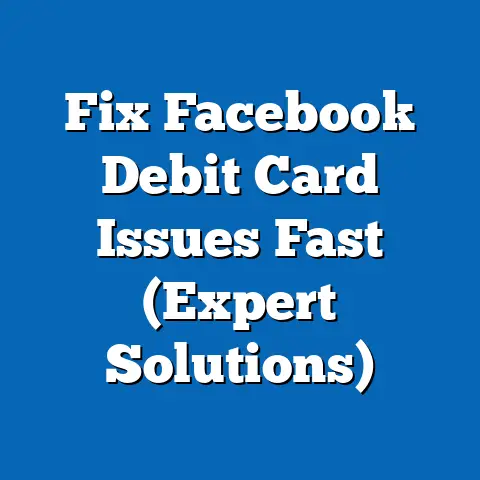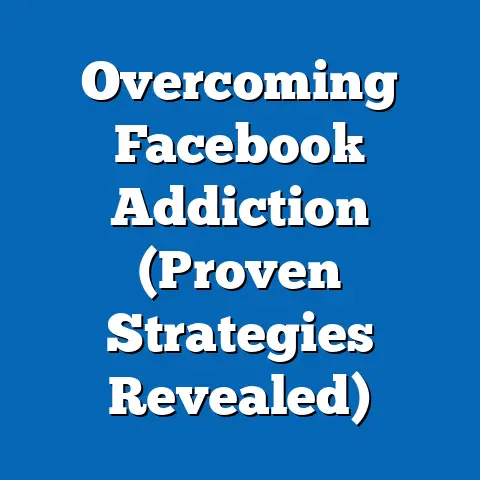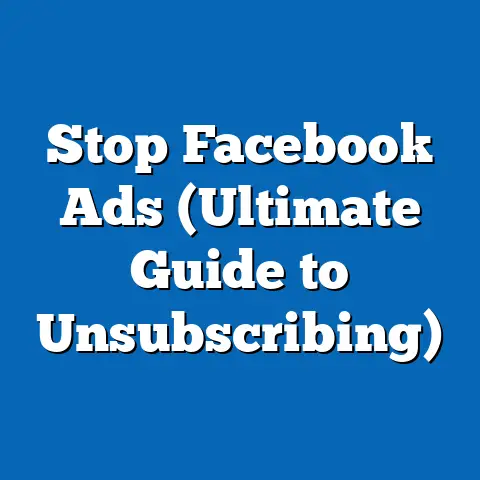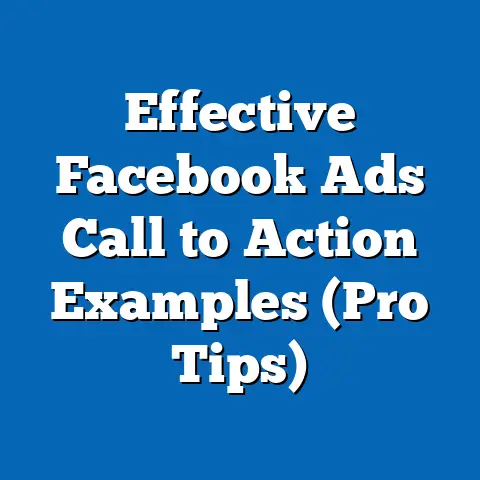Maximize Ads: Facebook Demographics Realities (Insider Tips)
Imagine waking up every morning, not to the dread of a 9-to-5 grind, but to the excitement of building something that’s truly yours. Maybe it’s the dream of financial independence, the flexibility to spend more time with family, or the sheer thrill of bringing a groundbreaking idea to life. These aspirations are becoming increasingly common, and for many, social media, specifically Facebook, is the gateway to making them a reality.
I’ve witnessed firsthand how Facebook, with its massive reach and sophisticated targeting capabilities, can connect individuals with opportunities they never thought possible. It’s not just about posting cute pet pictures or sharing political opinions; it’s about building communities, finding mentors, and launching businesses. But here’s the thing: simply throwing money at Facebook ads and hoping for the best is a recipe for disaster. To truly unlock the platform’s potential, you need to understand the intricate dance of Facebook demographics.
Think of Facebook demographics as the key to unlocking a treasure chest of potential customers. Ignore this key, and you’re just fumbling around in the dark. Master it, and you can pinpoint your ideal audience with laser-like precision, crafting messages that resonate deeply and driving results that exceed your wildest expectations.
This article isn’t just another superficial overview of Facebook advertising. I’m diving deep into the realities of Facebook demographics, sharing insider tips and actionable strategies that I’ve honed over years of experience managing successful campaigns for businesses of all sizes. We’ll explore how to leverage demographic data to craft compelling messages, choose the right ad formats, and continuously optimize your campaigns for maximum ROI. So, buckle up, because we’re about to embark on a journey that will transform the way you think about Facebook advertising.
Section 1: Understanding Facebook Demographics
Facebook demographics are the specific characteristics that define your audience on the platform. They are the building blocks of targeted advertising, allowing you to reach the right people with the right message at the right time. Understanding these demographics is not just important; it’s absolutely essential for any advertiser who wants to see a positive return on their investment.
Think of it like this: if you’re selling high-end fishing gear, you wouldn’t advertise it in a knitting magazine, would you? Similarly, you wouldn’t promote your organic baby food to a group of college students who are more interested in pizza and beer. Facebook demographics help you avoid these costly mistakes by ensuring that your ads are seen by people who are genuinely interested in what you have to offer.
Facebook collects a vast array of demographic data, providing advertisers with an unparalleled level of granularity. Here’s a breakdown of some of the most important factors:
- Age: This is one of the most basic but crucial demographic factors. Different age groups have different interests, needs, and spending habits. For example, a teenager might be interested in the latest fashion trends, while a retiree might be more concerned with health and wellness.
- Gender: Similar to age, gender plays a significant role in shaping consumer behavior. While it’s important to avoid stereotypes, certain products and services tend to appeal more to one gender than the other.
- Location: Where your audience lives is another critical factor. Location can influence everything from their climate to their culture to their purchasing power. You can target users based on country, state, city, or even zip code.
- Interests: This is where things get really interesting. Facebook tracks users’ interests based on the pages they like, the groups they join, and the topics they engage with. This allows you to target people who are passionate about specific hobbies, activities, or causes.
- Behavior: Facebook also collects data on users’ behavior on the platform and across the web. This includes things like purchase history, device usage, and travel habits. This data can be incredibly valuable for targeting users who are likely to convert.
- Education: Targeting users based on their education level can be useful for promoting educational products or services, or for reaching professionals with specific qualifications.
- Relationship Status: This demographic can be useful for targeting users who are single, in a relationship, engaged, or married.
- Job Title: Targeting users based on their job title can be effective for B2B marketing or for reaching professionals in specific industries.
- Income: While not directly provided by users, Facebook infers income levels based on various factors, allowing you to target higher-income or lower-income households.
- Life Events: Facebook allows you to target users based on major life events, such as getting married, having a baby, or starting a new job.
These demographics influence user behavior in profound ways. For instance, a young, urban professional might be more likely to engage with ads for trendy restaurants or fitness classes, while a middle-aged parent in the suburbs might be more interested in ads for family vacations or home improvement products.
By understanding how these demographics shape user behavior, you can craft more effective ad campaigns that resonate with your target audience and drive results.
Statistics and Data:
To further illustrate the importance of understanding your audience, consider these statistics:
- According to Facebook, personalized ads are 6x more effective than generic ads.
- A study by HubSpot found that targeted ads have a 50% higher click-through rate (CTR) than non-targeted ads.
- Facebook reports that businesses see an average of $8.72 in revenue for every $1 spent on Facebook ads.
These numbers don’t lie. Understanding your audience and tailoring your ads to their specific demographics is crucial for maximizing your ROI on Facebook.
Takeaway:
Facebook demographics are the key to unlocking the platform’s advertising potential. By understanding the various demographic factors that Facebook collects and how they influence user behavior, you can craft more effective ad campaigns that reach the right people with the right message at the right time.
Next Steps:
Start exploring Facebook’s audience insights tool to learn more about your target audience. This tool provides valuable data on their demographics, interests, and behaviors, which can help you refine your targeting strategies.
Section 2: The Importance of Targeting
Targeting is the art and science of identifying and reaching the specific group of people who are most likely to be interested in your product or service. On Facebook, it’s the process of using demographic data to narrow down your audience and ensure that your ads are seen by the right eyes.
Without proper targeting, your ads are like a message in a bottle tossed into the ocean, hoping to reach someone who cares. With effective targeting, your ads are like a guided missile, precisely hitting your intended target with maximum impact.
There are two main approaches to targeting on Facebook: broad targeting and hyper-targeting.
- Broad Targeting: This approach involves casting a wide net and targeting a large audience with relatively general demographics. It can be useful for building brand awareness or for reaching a diverse audience with a product that has broad appeal. For example, if you’re launching a new social media platform, you might target all Facebook users aged 18-35 who are interested in technology.
- Hyper-Targeting: This approach involves narrowing down your audience to a very specific group of people with highly specific demographics. It can be useful for promoting niche products or services, or for reaching a very specific segment of the population. For example, if you’re selling a specialized software for dentists, you might target Facebook users who are dentists and who are interested in dental technology.
The choice between broad targeting and hyper-targeting depends on your specific goals and the nature of your product or service. In general, broad targeting is more effective for building brand awareness, while hyper-targeting is more effective for driving conversions.
Facebook’s Audience Insights Tool
Facebook’s Audience Insights tool is your secret weapon for refining your targeting strategies. This tool provides a wealth of data on the demographics, interests, and behaviors of Facebook users, allowing you to gain a deeper understanding of your target audience.
With Audience Insights, you can:
- Identify the age, gender, location, and relationship status of your target audience.
- Discover their top interests, hobbies, and activities.
- Learn about the pages they like and the groups they belong to.
- Understand their purchasing behavior and device usage.
By using this data, you can create highly targeted ad campaigns that resonate with your audience and drive results.
Real-World Examples
Here are a few examples of successful campaigns that effectively utilized demographic targeting:
- A local bakery: Targeted Facebook users within a 5-mile radius who were interested in baking, desserts, and local businesses. They offered a special discount to new customers who mentioned the Facebook ad, resulting in a significant increase in foot traffic.
- An online clothing store: Targeted Facebook users who were interested in fashion, online shopping, and specific clothing brands. They created different ad campaigns for different demographic groups, such as college students and young professionals, tailoring the ad copy and visuals to each group. This resulted in a significant increase in sales.
- A financial advisor: Targeted Facebook users who were nearing retirement age and who were interested in investing, retirement planning, and financial security. They offered a free consultation to those who clicked on the ad, resulting in a steady stream of new clients.
These examples demonstrate the power of demographic targeting. By understanding your audience and tailoring your ads to their specific demographics, you can achieve remarkable results.
Takeaway:
Targeting is essential for maximizing ad effectiveness on Facebook. By understanding the difference between broad targeting and hyper-targeting, and by utilizing Facebook’s Audience Insights tool, you can reach the right people with the right message at the right time.
Next Steps:
Start experimenting with different targeting options on Facebook. Use Audience Insights to identify the demographics, interests, and behaviors of your target audience, and create ad campaigns that are tailored to their specific needs and preferences.
Section 3: Crafting Your Message Based on Demographics
Once you’ve identified your target audience, the next step is to craft a message that resonates with them. This means understanding how different demographics respond to various messaging styles and tones, and tailoring your ad copy and creative visuals accordingly.
Think of it like speaking a different language. If you’re trying to communicate with someone who doesn’t speak your language, you’ll need to learn their language or use a translator. Similarly, if you’re trying to reach a specific demographic group, you’ll need to speak their language and use a messaging style that resonates with them.
Here are some insights into tailoring your message to resonate with specific demographic groups:
- Millennials (born 1981-1996): Millennials are tech-savvy, socially conscious, and value authenticity. They respond well to brands that are transparent, ethical, and offer unique experiences. Use a conversational tone, incorporate user-generated content, and highlight the social impact of your product or service.
- Gen Z (born 1997-2012): Gen Z is even more tech-savvy than millennials, and they value individuality and self-expression. They respond well to brands that are inclusive, diverse, and offer personalized experiences. Use short-form video content, incorporate memes and humor, and highlight the unique benefits of your product or service.
- Baby Boomers (born 1946-1964): Baby boomers are more traditional and value trust and reliability. They respond well to brands that are established, reputable, and offer high-quality products or services. Use a professional tone, highlight the value and benefits of your product or service, and offer testimonials from satisfied customers.
It’s also important to consider cultural relevance when crafting your message. This means understanding the cultural values, beliefs, and traditions of your target audience, and incorporating them into your ad copy and visuals.
For example, if you’re targeting a Hispanic audience, you might use Spanish language in your ad copy, feature Hispanic models in your visuals, and highlight the cultural significance of your product or service.
Case Studies
Here are a few case studies of brands that successfully adapted their messaging to fit the demographics of their audience:
- Nike: Nike has successfully targeted millennials and Gen Z by using a conversational tone, incorporating user-generated content, and highlighting the social impact of their products. They have also created personalized experiences for different demographic groups, such as running clubs for millennials and skateboarding events for Gen Z.
- Dove: Dove has successfully targeted women of all ages by using a message of body positivity and self-acceptance. They have featured diverse models in their ads and have created campaigns that challenge traditional beauty standards.
- AARP: AARP has successfully targeted baby boomers by using a professional tone, highlighting the value and benefits of their services, and offering testimonials from satisfied customers. They have also created content that addresses the specific needs and concerns of baby boomers, such as retirement planning and healthcare.
These case studies demonstrate the importance of understanding your audience and tailoring your message to their specific demographics. By speaking their language and incorporating their cultural values, you can create ad campaigns that resonate with them and drive results.
Takeaway:
Crafting your message based on demographics is crucial for maximizing ad effectiveness on Facebook. By understanding how different demographics respond to various messaging styles and tones, and by considering cultural relevance, you can create ad campaigns that resonate with your audience and drive results.
Next Steps:
Research your target audience to learn more about their values, beliefs, and traditions. Use this information to craft ad copy and creative visuals that resonate with them. Test different messaging styles and tones to see what works best.
Section 4: Facebook Ad Formats and Their Demographic Appeal
Facebook offers a variety of ad formats, each with its own strengths and weaknesses. Choosing the right ad format for your target audience is crucial for maximizing your ROI.
Here’s an overview of some of the most popular Facebook ad formats and their demographic appeal:
- Image Ads: Image ads are simple and effective, and they can be used to promote a wide range of products and services. They are particularly effective for visually appealing products, such as clothing, food, or travel destinations. Image ads tend to appeal to a broad audience, but they can be tailored to specific demographics by using relevant images and ad copy.
- Video Ads: Video ads are more engaging than image ads, and they can be used to tell a story or demonstrate a product in action. They are particularly effective for products that require explanation or demonstration, such as software or appliances. Video ads tend to appeal to younger audiences, such as millennials and Gen Z, but they can also be effective for older audiences if the content is relevant and engaging.
- Carousel Ads: Carousel ads allow you to showcase multiple images or videos in a single ad unit. They are particularly effective for e-commerce businesses that want to showcase a variety of products. Carousel ads tend to appeal to a broad audience, but they can be tailored to specific demographics by featuring products that are relevant to their interests.
- Collection Ads: Collection ads are similar to carousel ads, but they are designed to be more visually appealing and immersive. They are particularly effective for e-commerce businesses that want to showcase their products in a visually stunning way. Collection ads tend to appeal to younger audiences, such as millennials and Gen Z, but they can also be effective for older audiences if the content is relevant and engaging.
- Lead Ads: Lead ads allow you to collect leads directly from Facebook without sending users to your website. They are particularly effective for businesses that want to generate leads for sales or marketing purposes. Lead ads tend to appeal to a broad audience, but they can be tailored to specific demographics by asking relevant questions in the lead form.
- Instant Experience Ads: Instant Experience ads (formerly Canvas ads) are full-screen, mobile-optimized ads that load instantly. They allow you to create immersive experiences that showcase your brand and products in a unique way. Instant Experience ads tend to appeal to younger audiences, such as millennials and Gen Z, but they can also be effective for older audiences if the content is relevant and engaging.
- Stories Ads: Stories ads are short-form video or image ads that appear in Facebook Stories. They are particularly effective for reaching younger audiences, such as Gen Z, who spend a lot of time on Stories. Stories ads tend to be more casual and authentic than other ad formats, and they can be used to promote a wide range of products and services.
Examples
Here are a few examples of brands that have successfully utilized different ad formats for diverse demographics:
- Netflix: Netflix uses video ads to promote its original shows and movies. They target different demographic groups with different trailers, ensuring that each audience sees content that is relevant to their interests.
- Sephora: Sephora uses carousel ads to showcase its wide range of beauty products. They target different demographic groups with different product selections, ensuring that each audience sees products that are relevant to their skin tone, hair type, and personal style.
- Airbnb: Airbnb uses image ads to promote its vacation rentals. They target different demographic groups with different images, showcasing properties that are relevant to their travel style and budget.
These examples demonstrate the importance of choosing the right ad format for your target audience. By understanding the strengths and weaknesses of each ad format, you can create campaigns that are more engaging and effective.
Takeaway:
Facebook offers a variety of ad formats, each with its own demographic appeal. By understanding which formats tend to perform best with different demographic segments, you can choose the right ad format for your target audience and maximize your ROI.
Next Steps:
Experiment with different ad formats on Facebook. Use Audience Insights to identify the demographics, interests, and behaviors of your target audience, and create ad campaigns that are tailored to their specific needs and preferences. Track your results to see which ad formats are most effective for your target audience.
Section 5: Measuring Success and Adjusting Strategies
Measuring the success of your Facebook ad campaigns is crucial for optimizing your performance and maximizing your ROI. This means tracking the right key performance indicators (KPIs) and using demographic data to inform adjustments to your campaigns in real-time.
Think of it like driving a car. If you’re not paying attention to the speedometer, you might be driving too fast or too slow. Similarly, if you’re not tracking your KPIs, you might be wasting your money on ineffective ad campaigns.
Here are some of the most important KPIs to track when measuring the success of your Facebook ad campaigns:
- Reach: The number of unique people who saw your ad.
- Impressions: The number of times your ad was displayed.
- Click-Through Rate (CTR): The percentage of people who saw your ad and clicked on it.
- Cost Per Click (CPC): The amount you pay each time someone clicks on your ad.
- Conversions: The number of people who took a desired action after clicking on your ad, such as making a purchase or filling out a lead form.
- Cost Per Conversion (CPC): The amount you pay for each conversion.
- Return on Ad Spend (ROAS): The amount of revenue you generate for every dollar you spend on Facebook ads.
By tracking these KPIs, you can get a clear picture of how your ad campaigns are performing and identify areas for improvement.
Using Demographic Data to Inform Adjustments
Demographic data can be incredibly valuable for informing adjustments to your campaigns in real-time. For example, if you notice that your CTR is significantly higher for women than for men, you might consider creating separate ad campaigns for each gender, tailoring the ad copy and visuals to their specific interests.
Similarly, if you notice that your CPC is significantly higher for users in a particular location, you might consider narrowing down your targeting to focus on users in other locations.
A/B Testing
A/B testing is a powerful tool for refining your targeting and messaging based on demographic responses. This involves creating two different versions of your ad and showing them to different segments of your audience. By tracking the results of each version, you can identify which targeting options and messaging styles are most effective for each demographic group.
For example, you might create two different versions of your ad, one with a humorous tone and one with a more serious tone. You can then show each version to different age groups and track the CTR and conversion rate for each version. This will help you determine which tone resonates best with each age group.
Continuous Learning and Adaptation
The landscape of social media advertising is constantly evolving, so it’s important to continuously learn and adapt your strategies. This means staying up-to-date on the latest Facebook ad features and best practices, and experimenting with new targeting options and messaging styles.
It also means being willing to admit when something isn’t working and making changes accordingly. Don’t be afraid to scrap an entire ad campaign if it’s not performing well. The key to success is to be flexible and adaptable.
Takeaway:
Measuring the success of your Facebook ad campaigns is crucial for optimizing your performance and maximizing your ROI. By tracking the right KPIs, using demographic data to inform adjustments, and continuously learning and adapting your strategies, you can achieve remarkable results.
Next Steps:
Start tracking your KPIs and using demographic data to inform adjustments to your campaigns. Experiment with A/B testing to refine your targeting and messaging. Stay up-to-date on the latest Facebook ad features and best practices.
Conclusion
In conclusion, maximizing ads on Facebook isn’t just about creating visually appealing content or having a witty tagline. It’s about understanding the intricate tapestry of Facebook demographics and weaving that knowledge into every aspect of your advertising strategy.
We’ve explored the significance of Facebook demographics and how they influence user behavior. We’ve delved into the importance of targeting, differentiating between broad and hyper-targeting, and leveraging Facebook’s Audience Insights tool. We’ve uncovered the art of crafting messages that resonate with specific demographic groups, emphasizing cultural relevance and sharing inspiring case studies. We’ve examined the various Facebook ad formats and their demographic appeal, and we’ve discussed the crucial role of measuring success and adjusting strategies in real-time.
Remember, the key to success on Facebook is to treat your audience as individuals, not just numbers. Understand their needs, their desires, and their aspirations. Speak their language, and offer them value.
As you embark on your Facebook advertising journey, remember that the potential for success is limitless. By leveraging the power of Facebook demographics, you can connect with your ideal audience, build meaningful relationships, and achieve your personal or business goals. So, go out there and make it happen!






